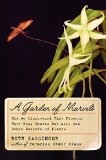Summary | Excerpt | Reading Guide | Reviews | Beyond the Book | Readalikes | Genres & Themes | Author Bio
How We Discovered that Flowers Have Sex, Leaves Eat Air, and Other Secrets of Plants

Critics' Opinion:
Readers' Opinion:
First Published:
Feb 2014, 416 pages
Paperback:
Mar 2015, 416 pages
 Book Reviewed by:
Book Reviewed by:
Heather A Phillips
Buy This Book
Certain grasses in the tropics evolved a couple of anatomical and physiological tricks that allowed them to get around this inefficiency. These "C4" plants developed a new biochemical pathway (only discovered by scientists in 1966) that starts by putting carbon into a four-carbon, instead of a three-carbon, compound (hence "C4" and "C3"). That compound is pumped into bundle-sheath cells, the cells that surround leaf veins. In C4 plants, the bundle-sheath cells themselves photosynthesize, while in C3 plants they typically do not. More important, in the C4s these cells are able to concentrate carbon dioxide at a higher level than is in the atmosphere. RuBisCO therefore contacts and interacts with more carbon dioxide molecules than it otherwise would, so more sugars are created. Because the bundle-sheath cells are impermeable to oxygen, less wasteful oxygen fixation occurs.
In sum, C4 plants learned how to make more hay—about 40 percent more—while the sun shines. That is why although they represent only 1 percent of the world's plant species, they represent 20 percent of the Earth's vegetation coverage and produce about 30 percent of terrestrial carbon. That is also why fourteen out of the eighteen of the world's worst weeds (we're looking at you, crabgrass and pigweed) are C4 species. And that is why miscanthus is a prime candidate for making biofuel. Moreover, it turns out that among C4s, miscanthus is especially good at accumulating carbon, even in a climate as untropical as Ontario. In the spring, miscanthus sends up new shoots from its rhizomes several weeks earlier than corn, which has to develop from seed, and even switchgrass. Its leaves continue to photosynthesize weeks after those two have called it a season. I am not surprised to learn, looking at the impenetrable mass of leaves in front of me, that miscanthus has more leaves with a larger collective surface than other C4s.
By the spring of 2008, using a combination of microscopic tissue culture and by manually dividing and redividing rhizomes, Dean turned Dr. Long's five rhizomes into thousands, and planted them on sixty acres. By the end of one growing season Dean had ten times the number of plants that the university had. By 2014, Dean expects his tomato farm will be energy self-sufficient.
The psychological benefits of energy independence are considerable, but does growing miscanthus make business sense? Dean has four hundred marginally productive acres of his own in miscanthus, and he contracts with neighboring farmers to grow the rest. Dean figures that the cost of a gigajoule (a billion joules) of miscanthus-made energy is $4.20. Natural gas, which is cheap at the moment, costs about $6.50 per gigajoule. It doesn't take a special furnace to burn the biofuel. At least on paper, miscanthus fuel is a winner.
The environment comes out ahead, too. Burning coal, natural gas, and oil that has been sequestered underground since the Carboniferous era releases climate-warming carbon dioxide into the atmosphere. While burning miscanthus in the winter adds carbon dioxide to the atmosphere, miscanthus took that carbon dioxide from the atmosphere in the spring and summer as it grew. The only fuel Dean uses in producing miscanthus energy is a little diesel for harvesting and baling the crop. In three years, he expects his farm will be nearly carbon neutral, which in a world where carbon dioxide levels are rising at an unprecedented rate is a significant accomplishment.
There are other environmental benefits, as well. Over the course of a summer, as the canes grow, the older, lower leaves fall off. They decay gradually, and will eventually return carbon and nutrients to the soil, but until then, the thick leaf litter provides good cover for small wildlife. The fallen leaves also slow evaporation from the soil. The underground portion of a miscanthus plant is equal in mass to the aboveground portion, which means it has a substantial impact on the subterranean ecology. The perennial roots of miscanthus reach deep into the ground, where they aerate the soil, leak nutrients to worms and insects, and add organic material to create a rich subterranean ecosystem. In terms of environmental impact, it is a crop much like perennial wheat, the holy grail of the Land Institute. Even better, it grows where no self-respecting wheat would grow.
Excerpted from A Garden of Marvels by Ruth Kassinger. Copyright © 2014 by Ruth Kassinger. Excerpted by permission of William Morrow. All rights reserved. No part of this excerpt may be reproduced or reprinted without permission in writing from the publisher.





The Flower Sisters
by Michelle Collins Anderson
From the new Fannie Flagg of the Ozarks, a richly-woven story of family, forgiveness, and reinvention.

The House on Biscayne Bay
by Chanel Cleeton
As death stalks a gothic mansion in Miami, the lives of two women intertwine as the past and present collide.

The Funeral Cryer by Wenyan Lu
Debut novelist Wenyan Lu brings us this witty yet profound story about one woman's midlife reawakening in contemporary rural China.
Your guide toexceptional books
BookBrowse seeks out and recommends the best in contemporary fiction and nonfiction—books that not only engage and entertain but also deepen our understanding of ourselves and the world around us.